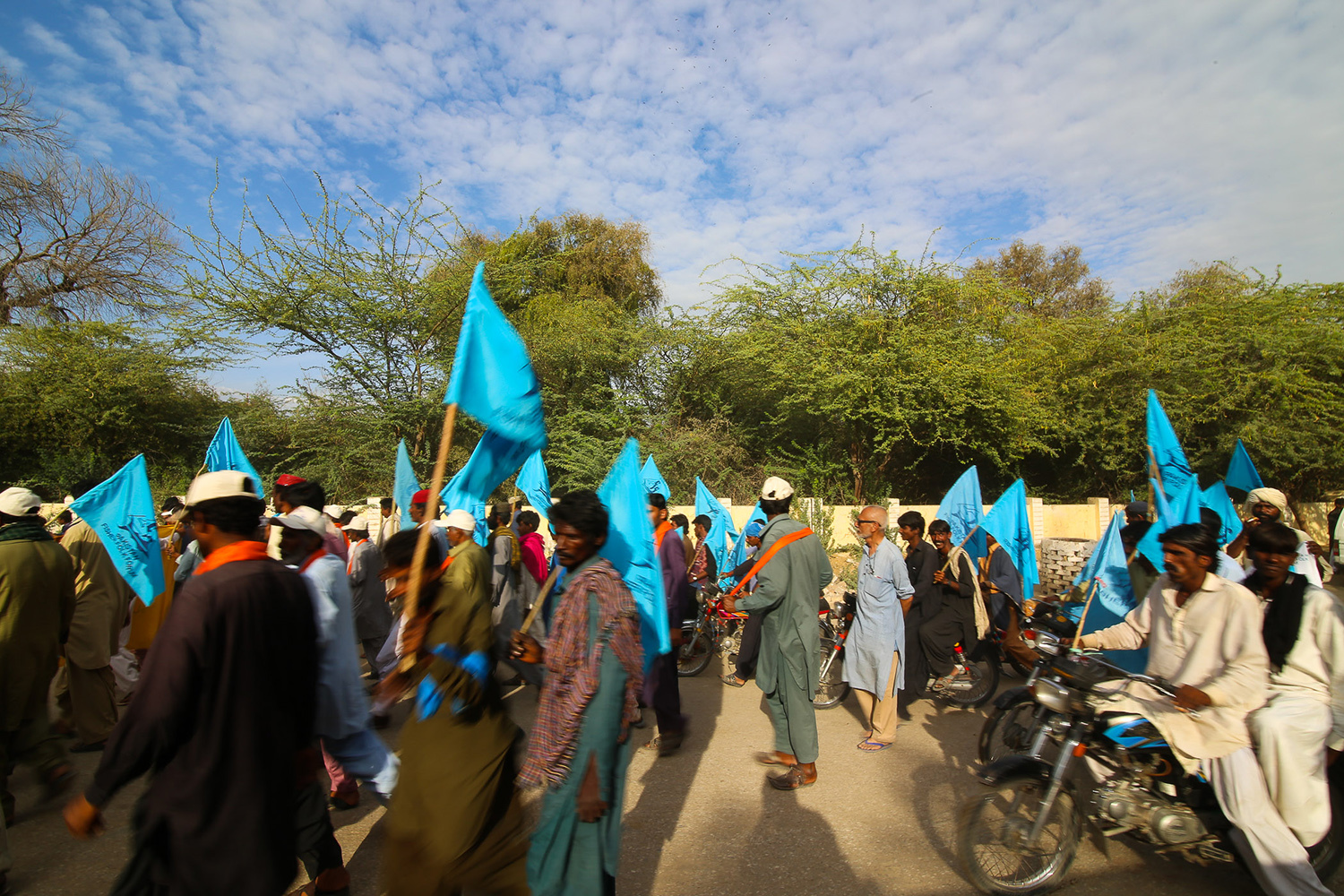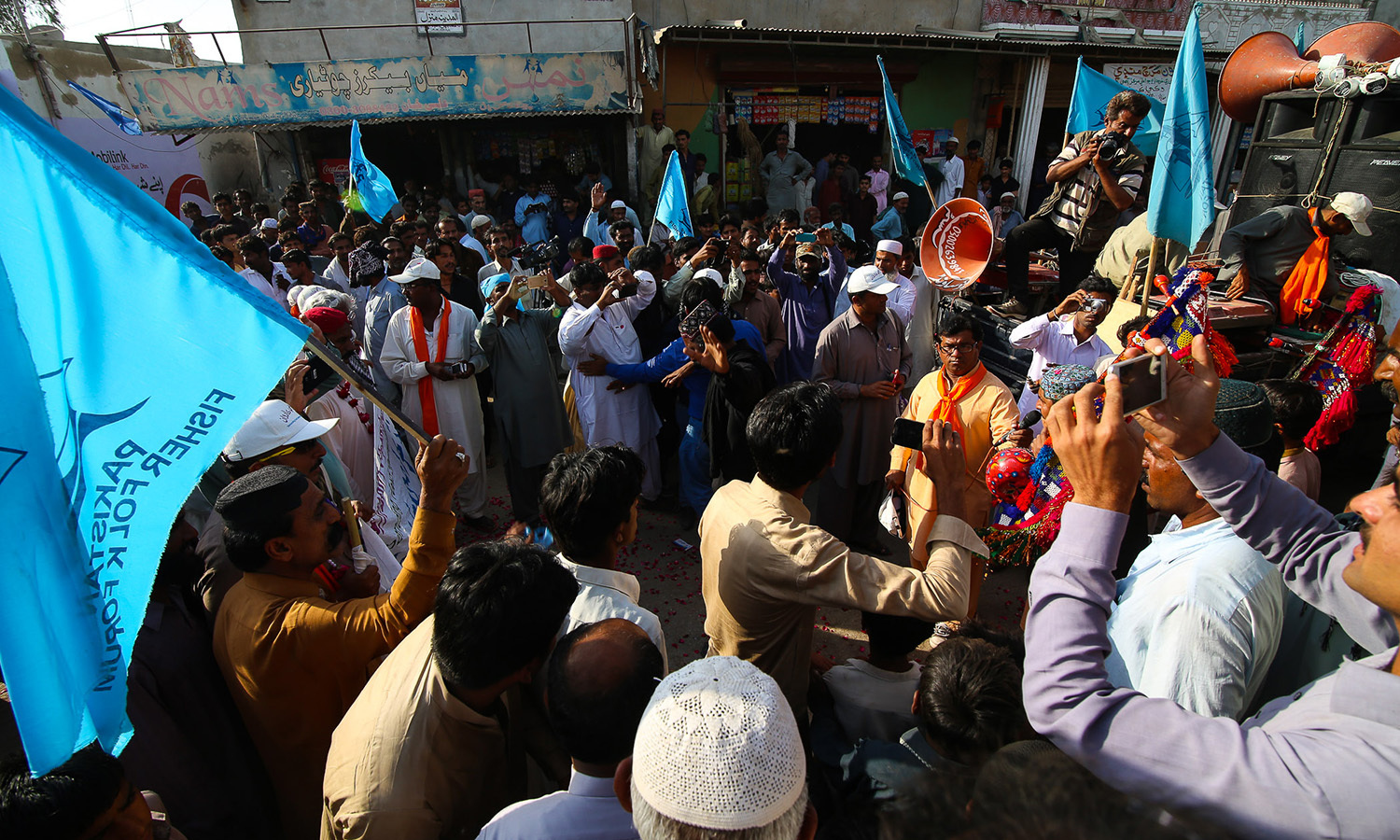Sindh Awaami Caravan: a peasant movement seeks to fight food insecurity
On a warm March afternoon, one can hear the faint sound of Sindhi music outside the Umerkot Press Club. A navy blue truck approaches; it is loaded with two huge speakers, four large megaphones and blue flags of the Pakistan Fisherfolk Forum (PFF).
The PFF’s co-chair Muhammad Ali Shah, surrounded by the organisation’s members, follows closely behind. This group has gotten together on an important mission: to galvanise and inform indigenous communities on issues of food sovereignty and climate justice.
Shah is holding a white cloth banner with the words “Sindh Awaami Caravan” — the Sindh People’s Caravan. Under the title is a subheading that reads:
“Demanding Food, Sovereignty, and Climate Justice.”
Read: 40pc of food in Pakistan is wasted
Among all this, a chant ensues: Hui jaagya! Jaagya! Haari jaagya! — Awaken! Awaken! Peasants, awaken!

March 1
The PFF begins its 14-day journey through the Indus Delta. The caravan consists of three buses, and a total of 50 people. Women, men, children, farmers, fishermen and indigenous activists are travelling from Karachi to Badin and Thatta, then east to Umerkot and north around the banks of the Indus River. Finally, they would culminate at the Kotri Barrage between Jamshoro and Hyderabad.
Pakistan has missed its Millennium Development Goals on eliminating hunger, according to the Food and Agricultural Organisation of the United Nations (FAO), Pakistan. In fact, hunger has risen in the country.
As per media reports, 61 million Pakistanis are food insecure, which means they lack reliable access to a sufficient quantity of affordable, nutritious food. Sindh has the highest level of food insecurity with over 71pc households being deprived. The primary reason for hunger, poverty and inequality is the fact that resources are controlled by a select group of feudal landowners and corporations.
In the context of the climate crisis, food sovereignty has emerged as a new and broad idea to end hunger.
Explore: In-depth: Sindh destroyed, one calamity at a time
“It began as an international peasant movement under the umbrella of La Via Campesina — or the International Peasant’s Movement,” explains Mr Shah.
Mr Shah, who co-founded the PFF back in 1998, explains that the La Via Campesina has two components. The first is transferring the ownership of the sources of food production directly to the farmers. This includes the ownership of land, water and seed.

The second component is enacting farming practices that are based on agro-ecology, that is, they are environmentally and ecologically friendly. This is coupled with a fast-paced phasing out of capitalistic modes of industrial farming that are ecologically unstable and environmentally unfriendly.
La Via considers policymaking to be a part of the first component concerning ownership. The FAO has not yet adopted this idea, but peasant movements and fishing communities worldwide have begun advocating for policy reform under the UN agency’s purview.
Sounds simple enough: Equally distribute the land, rein in industrial modes of farming, and adopt safer practices for the land and the environment. But, can this shift in paradigm also fulfill our increasing demand for food?
Mr Shah believes so. He cites Cuba as a good example; the Cuban food crisis of the 1990s pushed its incumbent government to implement land reforms. They converted state-owned agricultural land to farming cooperatives, and encouraged citizens to farm rural lands and set up urban gardens using traditional methods. The country was one of the 38 countries that managed to meet their anti-hunger targets for 2015.
Pakistan, too, has employed traditional and organic methods of farming before — until the 1960s Green Revolution. Mr Shah dismisses the idea that cutting down on fertilisers will not generate enough yields. “Yes, there will be a reduction in cash crops and bio-fuels,” he says, “But food sovereignty is a direct resistance to capitalist modes of agriculture”.

Such modes of production seek to use land for profit, rather than for fulfilling basic needs like food. The shift in ownership and farming practices, therefore, will go hand-in-hand with rethinking how we view land and capital; using them to produce food crops rather than cash crops.
But unlike countries like Cuba, Pakistan does not have a strong peasants’ movement. “Land reforms are not easy in a country where they have been labeled anti-Islam,” Mr Shah says.
He is referring to the Qazlbash Waqf case and the subsequent declaration by the Federal Shariat Court in 1990, where land reforms were declared un-Islamic.
“This country needs a social movement comprising of the peasants, fisher-folk, and backed by civil society,” Shah feels. At the same time, political parties need to implement land reforms under their respective manifestos. The biggest obstacle is feudalism. Once the feudal system is dismantled, Pakistan can move to land reforms and slowly achieve food security, ushering in a real, people-led democracy.
“All of these are interconnected,” Mr Shah emphasises.
It is almost sundown and the members of the caravan board the buses. It is time to leave Umerkot and head on to our next stop, Dohro Naaro, a small town in the district. Everyone is visibly tired.
At Dohro Naaro, the caravan is greeted by local PFF activists; Mr Shah concludes the day with his final speech in the bazaar’s centre. We then head to the village of Allah Bachayo Mala to stay the night.

March 9
As the sun rises over the wheat field, farmers make their way to tend their crops. At the heart of food sovereignty is a fundamental transformation: the end of mass-produced, specific technologies that are land intensive and unsustainable.
Mr Hayat, a local schoolteacher, gives a brief account of how the land itself has changed and molded itself to cope with the industrialisation of agriculture. Previous farming methods never used chemicals and fertilisers on their lands. But as demands for yield increased, farmers like Hayat began adopting modern methods.
As a result, the land has gotten used to the chemicals and fertilisers. “It is just like a drug addict whose body is used to drug abuse,” Mr Hayat observes. Whenever there is farming trouble, more chemicals are injected to solve the problem.

Jaag, Mala, Jaag!
By 2pm, we have reached Shaheed Soraya Badshah Chowk at Phopri, Sanghar district. The caravan is in the town’s centre, surrounded by roadside eateries, sweetmeat shops, bakeries, vegetable hawkers, hardware and general stores. Mr Shah makes the day’s fourth address, explaining the caravan’s purpose under the bright sun.
Our next stop is Chotiari, Sanghar District. By the time we reach, it is 4pm, and the press club has transformed into a resting point. Everyone is served water, juices and biscuits. To energise the group, Maula Bux Mala — a local singer and musician — breaks into a short performance for the tired travellers.
Two hours later we arrive at the Chotiari Wetlands where we are greeted in the typical Sindhi tradition of dance, ajrak and a shower of rose petals.
The wetlands are part of the Bakar dam, constructed in 2002. The dam has a checkered history; a water reservoir project, it emerged as an extended component of the Left Bank Outfall Drain (LBOD) that was used as a strategy to remove salt and salinity in the Indus River Basin.
The dam was designed to store excess water during the flood season, and to replenish the lower Nara canal during drier months. At optimum capacity, the dam was supposed to irrigate about 60,000 hectares of land. But ill planning led to delays, and the project lapsed for five years before its inauguration in 2003.
Read: Do Pakistanis even want all the babies they end up
Delays aside, the construction severely impacted the ecology and economy of the area. Indigenous fishermen and farmers living around the farmlands found their lands inundated by the dam; 1000 families were displaced, the riverine forest was submerged and destroyed, and with time, water seepage into underground tables converted 30,000 hectares of cultivable land around the reservoir into infertile tracts.
Mohaliati insaaf ji zaroorat aahay! — We need climate justice!


March 10
The caravan is to arrive at Sanghar city, the district headquarters. A program has been arranged in memory of Taahira Ali Shah (Mr Shah’s late wife), a former leader of the PFF’s women wing. The navy blue truck leads our way, with its speakers on and the music flowing in all directions. As we move through the lands they work on, farmers, men, women and children look at our passing caravan.
At the Sanghar Press Club, the stage is set with an amalgamation of portraits of Ms Shah, who died a year ago. She played a pivotal role in galvanising and charging up the women of the indigenous communities of Sindh to speak up for their rights.
The program begins with everyone paying their respects to Ms Shah. This is followed by speeches, but from the start to end, the atmosphere is not one of grief. The mood is that of celebration — of her work as a community leader. It is a celebration of the lives she touched.

March 11
The caravan is headed for Nawabshah — or Benazirabad, as it is now called. The caravan travels in silence since it is time for Friday prayers. “If we play music, the religious community will strongly object to our presence,” says Ayoub Shah, a caravan member.
But that does not mean other activities have to come to a halt. The caravan members are lined outside the Nawabshah Press Club, undeterred from voicing their purpose:
Hui jaageerdaari nizaam, na manzoor!
Hui sarmaayadaari nizaam, na manzoor!
We don't want this feudal system, We don't accept this capitalist system
Without a policy of land reforms, Pakistan’s urbanisation and internal migration has hastened significantly. As per the United Nations’ World Urbanization Prospects report, today, the country’s urbanisation rate stands at 2.77pc. At this rate, about half of the country’s population will be residing in the cities by 2025.
Essentially, this makes us one of the fastest urbanising countries in the region. Mr Shah believes this rapid transformation of rural land to urban land will spark another food crisis. “Where will we go to search for farmland?” he asks earnestly. “Are we going to redesign our irrigation network? Where will the water come from, to source these new urban centres?”
To make matters worse, the improper use of land — using it to produce and export cash crops instead of combating hunger — leads to further food security. In Sindh’s case, this lack of a social safety net compounds farmers’ problem.
Read: The politics of agriculture
Critiquing this system, Mr Shah explains how capitalism survives by seeking to grow and expand its consumer base. Urban centres, therefore, have always grown this way, and become a positive indicator for the capitalist system.
Sadly, this does not fare well for the urban poor, whose access to food and nourishment is reduced due to inherent poverty and low wages. Reportedly, urban dwellers currently consume more processed food, which is not a healthy long-term practice. “You get the calories, but you don’t get the essential nutrients,” Mr Shah elaborates. Previously, much of Karachi’s food was sourced from its rural areas; today it comes mainly from Interior Sindh and Punjab. “This can be revived,” Mr Shah suggests. “If the city decides — and wants to — provide fresh and wholesome food to its citizens.”
Under a policy of achieving food sovereignty, populations and communities of citizens will have the power to decide what they want to grow and eat.

March 14
Standing on the Kotri Barrage, I realise it is the International Day of Action of Rivers. The spillways are partially open, and water from the Indus gushes out on the other side.
At the end of the road, the caravan has finally arrived at its final destination. Aside from the leading group, people spanning from all over Sindh have come; Badin, Thatta, Karachi, Thar, Mithi, Sanghar.
In the consistent spirit of the caravan, they cheer and shout slogans under the afternoon sun’s heat.
Sindho darya ji bahaal kro!
Kalabagh dam! Bandh kro!
Athori dam! Bandh kro!
Basha dam! Bandh kro!
Release the Indus River,
End (stop) the Kalabagh Dam,
End (stop) the Athori Dam,
End (stop) the Basha Dam
It is a strong and impassioned slogan with its own political ramification and history. It stems from the idea of dams being an obstruction in the natural flow of the river, which cause a limited amount of water to reach the deltaic region of Sindh.
“The river is the artery of the land,” Mr Shah says. “If you are going to arrest the flow upstream, its natural flow will end and cause the Indus delta to dry out at the confluence of the river and the sea. A lot of human lives are conjoined with this flow. So is the ecology. If you are going to build dams you will disturb the ecology and all lives associated with it.”
One might argue that dams are needed to secure water supply to urban centres. Mr Shah says this is a false idea. He says we must address the root of the problem. “When there were no dams or barrages, we still had water,” he says. Yes, the population was high. But we were spread out. It is the social and economic inequities that cause a domino effect in how people access resources to sustain themselves.
Because of food insecurity, people migrate to urban centres, and the need for dams increases. Here’s how: dams are, in principle, made for both agricultural purposes and generating electricity, with increased urbanisation the need for setting up more industries increases, and thus the water requirement in urban centre grows.
“But if the river is free, it will recharge the land.”

Mr Shah does not want people to stop using the river — but this use must not disturb the ecology. Environmentally unfriendly practices disturb the water cycle and therefore disturb people’s livelihoods and the natural system’s health. The costs add up over time, and effects are felt more adversely.
New research by Brazil's National Institute for Space Research (INPE) also suggests that dams contribute to greenhouse gas emissions. When the land is flooded, plants and other life forms decay and eventually rot and release methane (a greenhouse gas) into the air.
Mr Shah estimates that 40pc of the water is wasted in the irrigation system. More so, dams are unsustainable and they do not distribute water equally due to this wastage. He then explains how half of the water is wasted during distribution. “About 40 per cent of this water — about 40maf (million acre feet) — is wasted.”
Instead of building more dams, Mr Shah says we need to solve the problem of wastage. “It is cheaper to manage water and reduce the leaks because that consumes less resources,” he advises. “We should also plant crops that use less water. Once that is done, you won’t need to construct dams.”
He feels dams are built in Pakistan only because of the lobby and industry backing them. From construction companies to international finance institutions that fund these megaprojects, to the environment consultant companies — everyone wants dams to be built because it funds their existence.
At the barrage, Mr Shah makes his final speech which includes a list of demands to the present incumbent governments: stop building dams and barrages on the Indus River, restore the Indus Delta by releasing 35maf of water from the upper streams, end the feudal system of land holdings, implement land reforms followed by equal distribution of land among the landless farmers, cease the usage of pesticides and harmful chemicals on farmlands that damage the land and soil, encourage the use of natural seeds, and promote agro-ecological methods of farming.
Read: Survey ordered to document rural economy
His speech is followed by a celebration ceremony at the riverbanks, where the attendants pay their respects to their ‘mother.’

This community hopes that its grassroots-driven campaign will elicit a much-needed discourse on sustainability and economic inequalities, since they interconnect and affect the wider web of the River’s ecology. The task is herculean, but a question remains: between the current narrative of imposed development made of steel and concrete, and the need to bridge the existing gap between us and nature, is there a middle way?
Mr Shah sums it up nicely. “Urban centres will have to change their lifestyle,” he states. For example, if one looks towards the transportation sector, each family member wants his or her own car. If there was an alternative, such as a safe, comfortable and punctual mode of public transport, people might use fewer cars.
“The youth here will have to play pivotal role in this movement. Then we’ll have to take this understanding to the labour unions and their federations and make them understand the important relationship of their production with the changing climate. At the same time the elite will have to be pressured to adopt measures that reduce their own carbon footprint. A sustained movement under these parameters will help, at the least, limit runaway climate change and environmental destruction.”
“But all of this needs to be done from the top,” Mr Shah continues. This is the problem. The present democratic system seats capitalists at top posts, and these influential people make policies that suit them. When we talk about a successful movement — and an anti-capitalist one at that — it must build upon a stronger base. Shah believes that the labour class from urban centres, the middle and lower-middle class, and the working class have to team up with anti-capitalists to stop environmental destruction, because they are at risk of unemployment and poverty too.
“Until that happens, we won’t be able to change the system,” he says.


Basil Andrews is a cultural photographer and writer. His work revolves around urban spaces, and indigenous narratives on land and water. He tweets @_basilandrews.







